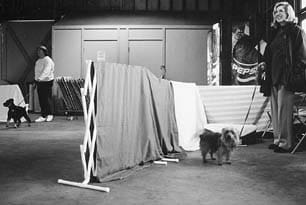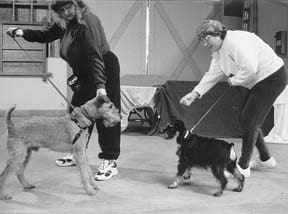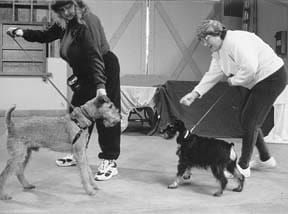[Updated November 16, 2017]
We used to call them growl classes – a term that, in hindsight, was perhaps a poor choice – likely to intensify feelings of apprehension in the human member of the training team before dog and owner even walked through the door into the classroom for the first session. These were classes designed for dogs whose aggressive on-leash reactions to dogs or other environmental stimuli made them inappropriate candidates for regular companion dog classes; they were simply too disruptive, even dangerous, to be in mixed company. See “Training Classes for Aggressive Dogs,” for a detailed description of a typical “growl” class.

While the term “growl class” may have mostly gone by the wayside, fortunately the concept of a class for difficult dogs has not. It is a tribute to dog owners of today that many of them are unwilling to give up on their canine companions, even when faced with behavior challenges that can shake the foundations of the dog-human bond. It’s as much a tribute to the modern dog training profession that trainers continue to seek out and develop innovative, positive, and effective solutions for owners who are committed to helping their dogs “be nice.” From east coast to west, trainers are increasingly offering classes that now go by friendlier names, such as “Feisty Fido,” the goal of which is to help owners help their difficult dogs be more manageable in the real world.
Is Your Dog Truly Aggressive?
Candidates for difficult dog classes are generally those who tend to react more intensely than the situation calls for. They may bark aggressively at other dogs on leash, lunge uncontrollably after joggers, or claw at car windows when someone passes by. While some of this is normal dog behavior – chasing things that move is a hardwired canine response – difficult dogs are distinguished by their owners’ sense of frustration and helplessness – they have tried all the remedies that worked just fine for their friends’ and neighbors’ dogs to no avail. Fido is still intimidatingly feisty. If you are reluctant to take your dog to a training class because of his embarrassing or frightening behavior, or the two of you have been excused from a regular class for the same reason, then you are good candidates for a canine “special education” class.
Most trainers who offer classes for Rowdy Rovers agree that, while dog-dog aggression is an allowable behavior problem for class participants, dog-human aggression is not. Ali Brown, CPDT, of Great Companions in Allentown, Pennsylvania, says, “If the owner tells me the dog is aggressive, fearful, etc., we explore further. If the dog hasn’t made bite contact, I will accept them – but we do a minimum of three private sessions first, focusing on calming and control exercises. If the dog has actually bitten, mauled, or attacked a person, then no, they don’t come to our Reactive Dog classes.”
Trish King, Director of Behavior and Training for the Marin Humane Society in Novato, California, suggests that her difficult dog classes are as much support groups for owners as they are vehicles to achieve the goal of helping the dog be civilized in the presence of other dogs. “The owners really encourage each other,” she says. “After a dog who used to be outrageous succeeds at a previously ‘impossible’ exercise, the other participants often break out in applause. No one can appreciate the progress of these dogs as much as owners of similar dogs!”
Caren Salisbury of Warner Robins, Georgia, agrees. “I offer classes for difficult dogs because I have found that owners are embarrassed to have an ‘out of control’ dog. They think they’re alone with the behavior, but quickly learn that they are not!” she says.
Methods and Tools Used in Aggressive Dog Classes
Brown and King both emphasize the importance of using positive tools and techniques, and they are not alone. Overwhelmingly, trainers use positive training and behavior modification tools and methods to work with Feisty Fidos. Owners bring their dogs’ soft beds to class, and the dogs relax in them in between more active parts of class, giving the dog a chance to “practice” calming down from an aroused state, even in the presence of other dogs. Treats, toys, and touch are used to reward dogs for their progress; these also work to classically condition the dogs to form more positive associations with being around other dogs.
“All our courses depend on positive, non-aversive, reward-based methodology,” says Jackie McGowan, of Click Starts Dog Training in Alberta, Canada. “Clicker training is used, unless the dog has a strong aversion to the sound of the clicker. We use canine and human positive relationship building, dog on owner focus, relaxation techniques, coping skills, alternate behavior skills and management skills.”
Physical barriers are commonly used in these classes, to block visual stimulation until dogs are ready for more interaction. King starts each dog in class in its own alcove to provide a safe, quiet environment. As dogs learn to relax, the “walls” of the alcove can be gradually opened.
Other trainers use physical distance to keep the dogs’ reaction to stimuli at a comfortable level. Brown uses the dogs’ own cars as barriers – the equivalent of large portable crates. Her clients park as far away from each other in the parking lot as possible and work with their dogs one at a time in and near their cars, very gradually working toward bringing the dogs closer together, still calm and controlled.
Another frequent tool of choice in these classes is the use of calming massage and touch. A number of trainers will, like Brown, require one or more private sessions to give them an opportunity to meet and work with dog and owner outside the stress and confusion of a group class. In these private sessions, trainers teach owners new techniques to respond to, redirect, and control inappropriate behaviors that will help lower the dogs’ arousal and reactivity rather than exacerbating it. Often, teaching the owner to remain calm is a huge step toward helping the dog maintain his mental equilibrium.
While some still use head halters, many trainers have ceased using them for difficult dogs in recognition of the increased stress level this tool may cause in some dogs. King suggests that if you need a head halter to control the dogs in class or a muzzle to ensure safety, perhaps the dogs are too close and too aroused anyway. She does enthusiastically promote the use of the SENSE-ation harness for these dogs, instead.
Training Class Goals
In the “olden days” – just a few years ago! – the goal of a growl class was often expressly to get all the dogs in the class playing together by the end of the six or eight weeks. Trainers have come to realize that for the most part this is an unrealistic goal, and one that places entirely too much stress on dogs and humans alike – trainers as well as owners! Today’s goals are inclined to be much more modest and humane.
“My biggest goal is to educate the owner on proper dog handling techniques: Preventing the dog from practicing the undesired behavior; being proactive and alert instead of reactive; teaching desensitization and counter-conditioning skills,” says Carole Lawson, CPDT, of the Classic Academy of Canine Learning in Cleveland, Ohio. “My goal for the dog is to help create a relationship between owner and dog where the dog is confident in the human and willing to be attentive to the owner regardless of the fear stimulus or other distraction.”
Valerie Pollard, of Valerie Pollard Dog Training, Orange, California, wants her difficult dog clients to learn to trust and enjoy focusing on their handlers, and be able to function calmly in social situations involving other dogs and people.
Different Kinds of Classes for Rowdy Dogs
Like most trainers who provide this type of service, Trish King agrees that owner education is a vital part of the program. She offers three different types of classes for dogs with challenging social behaviors, to create positive learning environments for the humans that are most conducive to addressing their dogs’ specific behaviors:
• Difficult Dogs: For dogs who are seriously aggressive toward other dogs
• Feisty Little Fidos: For difficult dogs who weigh 25 pounds or less, and
• ADD Dogs: For young adult dogs who are displaying “Adolescent Dog Disorder” – frustration or aggression on leash as a direct result of their strong desire to go play with other dogs.
The goals are similar but different for each type of class. For the Difficult Dogs, the aim is to increase the owner’s level of confidence and control, as well as modify canine behavior so their dogs are safe and civilized around other dogs. There is no expectation that these dogs will come to love and frolic with each other by the end of the eight-week program.
Feisty Little Fidos are also expected to learn to be civilized around others, although because of their smaller size, actual physical control is less of an issue.
ADD dogs are the group most likely to learn how to “play well with others” by the end of their classes. Their inappropriate behavior is driven by the thwarting of their strong desire to socialize, as opposed to truly agonistic motives. When owners are taught how to appropriately redirect and reward their dogs’ focus and attention, the frustrated arousal recedes. Owners in this class are often gratified by the ultimate miracle of seeing their dogs romping happily together with no signs of aggression.

Janet Smith, Behavior Program Manager for the Capital Area Humane Society offers two different types of classes for difficult dogs. Smith’s “Shy Dog” class is for dogs who have issues with humans, and the “Growls and Howls” program is for dogs who are reactive to other dogs. Her goal for her owners is education – helping them understand their dog while improving their management, training, and relationship. Her goal for the dogs is simply improvement.
Like most trainers, and especially those who work in or closely with shelters, Smith’s perennial goal is to keep the dogs in their homes. Owners who can see even small improvement in their dogs’ behaviors are more motivated to keep working with their dogs rather than giving up on them.
Finding a Dog Training Class Near You
Once a rarity, difficult dog classes can now be found in many communities. Even better, good difficult dog classes can be found in many communities.
If you aren’t conveniently located to one of the trainers listed here, try calling the one nearest you and asking if she knows anyone who may offer the classes closer to your town. You can even pick up your phone book, call the trainers listed there, and ask if they offer such classes.
You can also go to the Association of Pet Dog Trainers and click on its “Trainer Search” button. The site allows you to search by city and state for trainers near you, and while not all APDT members may fit our definition of a positive trainer, and not all of them offer classes for Rowdy Rovers, it’s a good place to start.
Research Classes Thoroughly!
Once you have located a class near you, you will need to investigate further. Brown makes the following suggestions for evaluating your potential difficult dog instructor:
• Observe a class in progress. If a trainer won’t let you observe a class, don’t bother to pursue it any further.
• Listen to the trainer speaking. She should discuss the science of behavior and learning, and explain concepts such as counter-conditioning, desensitization, and stress levels. She should not just tell people what to do with their dogs, but how, and especially why.
• Be absolutely sure the training is all positive. Handlers should be using buckle collars, leashes, harnesses, treats, clickers, etc. Anything that applies force is counterproductive. No choke chains, no prong collars, no shock collars.
King offers other suggestions:
• Be sure the instructor is experienced at teaching difficult dog classes. Everyone has to learn somewhere – usually as an assistant or apprentice – you don’t want you and your dog to be guinea pigs.
• Look for safety controls throughout the class. Dogs and owners should be set up to succeed safely. Equipment, methods, exercises and environments should all be designed to ensure safety; anything in the environment that puts dogs or humans at risk is not acceptable.
• Be absolutely sure the training is all positive reinforcement.
Patricia McConnell’s booklet, “Feisty Fido,” is included as a textbook by many trainers who teach difficult dog classes, and is an excellent adjunct to the information in this article. While hands-on assistance from a skilled trainer in the nurturing environment of a group class of owners facing the same challenges you are with your Rowdy Rover is ideal, McConnell’s book is a great backup tool that can start you in the right direction while you track down a suitable class.
Finally, don’t despair. You are not alone, and your dog’s behavior is probably not beyond all hope and help. Find yourself a good Feisty Fido class, and you just might be pleasantly surprised to find that it’s easier and far less painful than you thought to turn your difficult dog into a reliably good canine citizen.
TRAINING CLASSES FOR REACTIVE DOGS: OVERVIEW
1. Locate trainers in your area who offer difficult dog classes, taught with only positive methods and tools – no punishments, no choke or shock collars. Be ready to drive an hour or more for the right class.
2. Teach your dog (and practice, practice, practice) “look at me” and “off” or “leave it!” He must learn that it’s far more rewarding to pay attention to you than anything else.
Pat Miller, WDJ’s Training Editor, is a Certified Pet Dog Trainer, and past president of the Board of Directors of the Association of Pet Dog Trainers. She is also the author of, The Power of Positive Dog Training, and the just-released book, Positive Perspectives: Love Your Dog, Train Your Dog.





